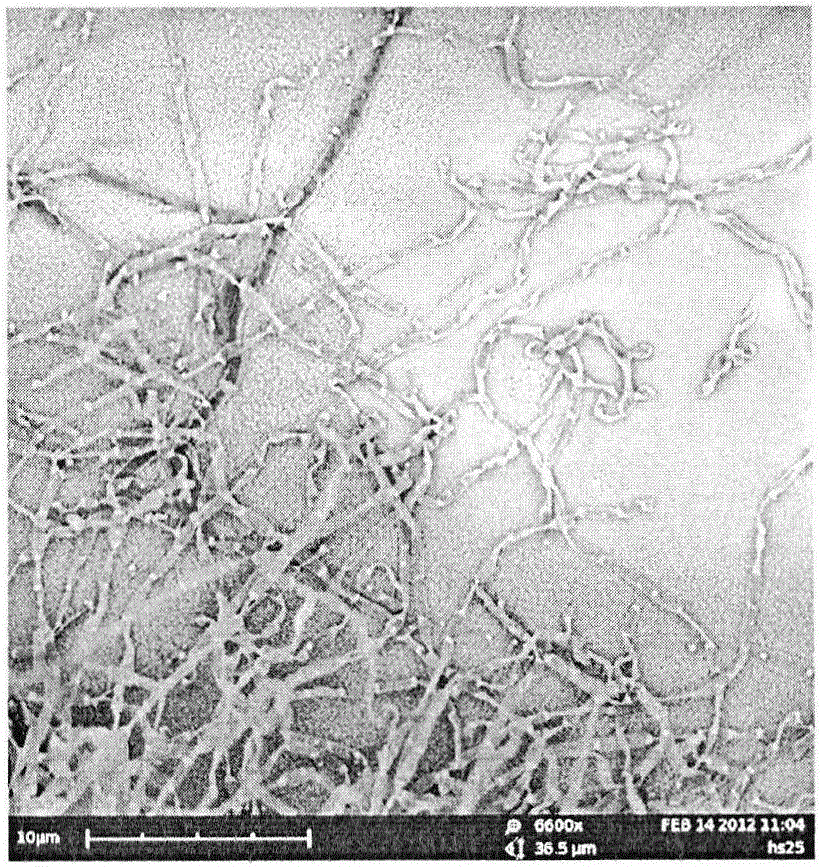Marine actinomycete strain with meloidogyne insecticidal activity and application of marine actinomycete strain
A technology of actinomycetes and strains, applied in the field of microorganisms, can solve problems such as harming human health, easily producing drug resistance, destroying the environment, etc.
- Summary
- Abstract
- Description
- Claims
- Application Information
AI Technical Summary
Problems solved by technology
Method used
Image
Examples
Embodiment 1
[0017] Example 1: Isolation of bacterial strain HA12420CGMCCNo.11063
[0018] Sediment samples were collected from the mangrove forest in Bamen Bay, Hainan Province. After 7 days of natural air-drying, 5 g of the sample was dissolved in 45 ml of sterile old sea water to make a soil suspension. Dilute gradually to 10 with sterile aged seawater -2 、10 -3 、10 -4 times, draw 100 μl of samples of different dilutions, spread on the actinomycetes isolation medium, and place the isolation plate in a 28°C incubator for upside-down culture. When the colonies grow out, pick colonies with different shapes and colors and streak them on Gaoshi No. 1 synthetic medium for purification until pure culture is obtained. After initial deduplication, number and save.
Embodiment 2
[0019] Embodiment 2: the cultivation of bacterial strain HA12420CGMCCNo.11063
[0020] (1) Incline culture: culture at 28°C for 7 days. Medium: 4.0g of yeast powder, 10.0g of malt extract, 4.0g of glucose, 1000mL of 50% aged seawater, pH7.2-7.4.
[0021] (2) Seed culture: pick an activated single colony from the slant and insert it into the seed medium, and culture it at 28° C. for 2-3 days. Medium: 4.0g of yeast powder, 10.0g of malt extract, 4.0g of glucose, 1000mL of 50% aged seawater, pH7.2-7.4.
[0022] (3) Fermentation culture: 5% inoculum amount was inserted into the seed culture solution, and cultured in shake flasks at 28° C. and 180 r / min for 6 days. Medium: 10.0g corn flour, 10.0g soybean flour, 5.0g soluble starch, K 2 HPO 4 0.5g, 50% aged sea water 1000ml, pH7.2-7.4.
Embodiment 3
[0023] Example 3: Anti-root-knot nematode activity detection of bacterial strain HA12420CGMCCNo.11063
[0024] Strain HA12420CGMCCNo.11063 was fermented and cultured according to the method in Example 2, and the fermentation product fermented for 6 days was collected, centrifuged at 10,000 r / min for 10 min, and the supernatant was filtered with a 0.22 μm sterile filter membrane for future use.
[0025] (1) preparation for testing nematodes
[0026] The nematodes tested were obtained from the diseased roots of pepper collected in the wild. Take the pepper diseased root, wash the surface soil with distilled water, pick out the egg masses inside the root knot with a dissecting needle, put them into a 24-well plate filled with 0.5mL sterile water, average 10-15 egg masses per well, and let them hatch at 28°C ; Collect the second-instar larvae (J2) of the root-knot nematode that hatched, mix gently in a 2mL centrifuge tube, and prepare a nematode suspension (about 3000 / mL).
[00...
PUM
 Login to View More
Login to View More Abstract
Description
Claims
Application Information
 Login to View More
Login to View More - R&D
- Intellectual Property
- Life Sciences
- Materials
- Tech Scout
- Unparalleled Data Quality
- Higher Quality Content
- 60% Fewer Hallucinations
Browse by: Latest US Patents, China's latest patents, Technical Efficacy Thesaurus, Application Domain, Technology Topic, Popular Technical Reports.
© 2025 PatSnap. All rights reserved.Legal|Privacy policy|Modern Slavery Act Transparency Statement|Sitemap|About US| Contact US: help@patsnap.com



